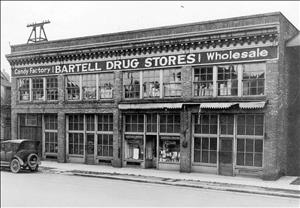In 1917, Bartell Drugs opens a photo lab at the company headquarters at 1906 Boren Avenue in Seattle. The lab will operate for about 40 years and will become a model for other drugstores looking to install similar labs.
Expanding on a Good Idea
Photo labs in Seattle weren't new when Bartell Drugs opened its lab in 1917. As early as 1908, you could buy lighting equipment (such as oil-burning lamps and candle-burning lanterns) for your own darkroom work from one of Bartell's rivals, The Quaker Drug Company. By 1911, you could have your pictures developed in the photo lab at Lowman and Hanford Company on 1st Avenue. What George Bartell did in 1917 was take a good idea and expand on it.
Bartell opened his lab at the company headquarters at 1906 Boren, where his warehouse, office, and candy factory were already located. It started out as a small affair, with one developer and a part-time assistant, but quickly grew. By 1922 there were fifteen employees working in the photo lab, and it developed pictures for more than 50,000 customers that year.
900 Rolls a Day
The lab continued to grow as photo technology improved and the number of Bartell stores expanded during the 1920s. By the time it was the subject of a Seattle Post-Intelligencer article in November 1932, the lab boasted six modern printing machines and an automatic film developing machine. The automatic developing machine was a big deal in 1932; it had only come out a few years earlier. "From the time the film is stripped from the roll in the dark room until it is dried and ready for printing it is not touched by human hands," emphasized the article.
In 1932, Bartell Drugs developed about 900 rolls of film a day. And if you dropped off your film at a Bartell store, you could count on having your pictures back fast. If you brought it in by 12:30 p.m., you could pick up developed pictures by 5 p.m., and if you brought it in between 12:30 and 4:30 p.m., it would be ready by noon the next day. To insure speedy service, Bartell's hired a motorcycle messenger who spent his days zipping through Seattle between the lab and each of Bartell Drugs' stores. (In 1932, there were 17.) He stopped at each store at least three times a day, sometimes more often.
The lab was able to take small prints and enlarge them up to 16 by 20 inches. It also had special equipment for mounting photographs and cutting them in outline. Another feature offered was a special airbrush colorizing process. This process took an ordinary black and white photograph and turned it into a color picture. (Color film as we now [2012] know it didn't come out until the mid-1930s and wasn't widely used for several more decades.) Though it was sometimes possible to tell the photograph had been retouched, it still added a nice touch to a family or personal portrait. Bartell employed retouch experts and colorists to handle these particular photographs.
Photo Contests and an Electric Eye
George Bartell always made sure to market everything Bartell Drugs had to offer, and the photo lab was no exception. During the late 1930s, Bartell's had a monthly "menu print competition" of its favorite photographs. In this friendly competition, the company selected what it felt was the best photograph out of the tens of thousands it developed each month. With the owner's permission, Bartell Drugs reprinted it on all its menu covers (during the 1930s, Bartell's served food in nearly all of its stores) for a month. Bartell's also compensated the photographer with a $5 cash prize -- equivalent to more than $80 in 2012 dollars.
The lab continued to thrive through the 1940s and into the 1950s under the management of L. L. Connell, who had worked in the lab since its 1919 opening. It was again featured in a 1950 Seattle Times article, which touted the lab's latest film processor and printer. Probably the biggest difference in this processor versus the one used 20 years earlier was that the newer processor (which the lab had actually owned since 1940) used an electric eye to time the printing exposure of the pictures rather than letting the processor operator make the call. The electric eye determined the density of tones in the photo negative and based its timer on this information to insure a uniform print.
The photo contests continued into the 1950s, though they had changed by 1950. Contests were now held weekly, and four pictures were selected each week. With the owner's approval, enlargements of the winning photographs were made and displayed in all Bartell stores during the following week. The photo owners got to keep the enlargement with the "prize-winner" seal after the display period ended.
The Lab Closes, but Processing Continues
By the mid-1950s, Bartell's photo lab days were numbered. Changing times were forcing the company to reinvent itself, and late in the decade the growing popularity of color film spelled the death knell for the photo lab. Color processing was then more expensive than black and white, and would have also required Bartell's to upgrade the lab. Bartell's was downsizing in the late 1950s, not spending money on upgrades. The lab closed.
But this was not the end of photo processing at Bartell Drugs. Sixty years later, you can walk into many Bartell Drug stores and have a print from a film camera developed within an hour in one of the photo-processing machines in the store. Or if you prefer, you can print your own digitally-stored pictures in just a few minutes at one of the "digital print centers" offered at Bartell stores. You can also e-mail them to a Bartell store and the store will print them and have them ready for you in an hour.

